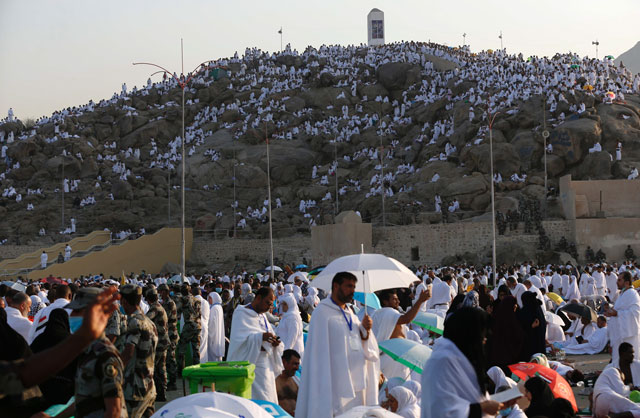
 A Muslim pilgrim prays on Mount Mercy on the plains of Arafat during the annual Hajj pilgrimage, outside the holy city of Makkah, Saudi Arabia September 11, 2016. PHOTO: REUTERS
A Muslim pilgrim prays on Mount Mercy on the plains of Arafat during the annual Hajj pilgrimage, outside the holy city of Makkah, Saudi Arabia September 11, 2016. PHOTO: REUTERSMore than 1.8 million gathered from sunrise at the hill and a vast surrounding plain known as Mount Arafat, about 15 kilometres (nine miles) from Makkah. They are spending the most important day of the annual Hajj in prayer and reading from the Quran.
Hajj nears climax for world's Muslims
 A Muslim pilgrim supplicates for God as he holds an umbrella on Mount Mercy on the plains of Arafat during the annual Hajj pilgrimage, outside the holy city of Makkah, Saudi Arabia September 11, 2016. PHOTO: REUTERS
A Muslim pilgrim supplicates for God as he holds an umbrella on Mount Mercy on the plains of Arafat during the annual Hajj pilgrimage, outside the holy city of Makkah, Saudi Arabia September 11, 2016. PHOTO: REUTERSArafat is the site where Muslims believe the Prophet Muhammad (pbuh) gave his last sermon about 14 centuries ago after leading his followers on the pilgrimage. "I have the impression of standing exactly in front of God,” said Khadem Ndyaye, 47, of Senegal. “Muslims came here from everywhere and we are all the same. If all the world was like that, there wouldn't be any war. Here, we feel that Islam is a religion of peace."
 A Muslim pilgrim prays on Mount Mercy on the plains of Arafat during the annual Hajj pilgrimage, outside the holy city of Makkah, Saudi Arabia September 11, 2016. PHOTO: REUTERS
A Muslim pilgrim prays on Mount Mercy on the plains of Arafat during the annual Hajj pilgrimage, outside the holy city of Makkah, Saudi Arabia September 11, 2016. PHOTO: REUTERSIndian pilgrim Mohammed Arafan, 40, said he feels "chosen by God" for being able to perform the Hajj. "It's beautiful to see the Muslims of the world pray together here." At midday prayer hundreds of thousands prostrated themselves, men and women side-by-side, in wide alleys that run between prefabricated pilgrim lodgings.
Saudi Grand Mufti not to deliver Hajj sermon for first time in 35 years
 A Muslim pilgrim reads a copy of the Quran, Islam's holy book, as he joins one of the Hajj rituals on Mount Arafat near Makkah early on September 11, 2016 Close to 1.5 million Muslims from around the world prepared on September 10 night for the climax of the annual Hajj pilgrimage at a rocky hill known as Mount Arafat. PHOTO: AFP
A Muslim pilgrim reads a copy of the Quran, Islam's holy book, as he joins one of the Hajj rituals on Mount Arafat near Makkah early on September 11, 2016 Close to 1.5 million Muslims from around the world prepared on September 10 night for the climax of the annual Hajj pilgrimage at a rocky hill known as Mount Arafat. PHOTO: AFPFor the first time in years, Saudi Arabia's Grand Mufti Abdul Aziz al-Sheikh did not give his traditional Arafat sermon. Okaz newspaper cited health reasons but Sheikh still attended the sermon given in his place by Abdul Rahman al Sudais, imam of Makkah's Grand Mosque.
 Muslim pilgrims leave after they finished their prayers at Namira Mosque in Arafat during the annual Hajj pilgrimage, outside the holy city of Makkah, Saudi Arabia September 11, 2016. PHOTO: REUTERS
Muslim pilgrims leave after they finished their prayers at Namira Mosque in Arafat during the annual Hajj pilgrimage, outside the holy city of Makkah, Saudi Arabia September 11, 2016. PHOTO: REUTERSUnder multi-coloured parasols to protect against the burning sun, the mass of people move through broad streets which are closed to traffic around Mount Arafat. Throughout the day the faithful chant a traditional Hajj incantation, "God, here I am." From a distance, the hill appeared a snowy white from the seamless two-piece white garment, ihram, worn by male pilgrims.
Hajj pilgrims get ID bracelets after deadly stampede

They come from every corner of the globe, but Indonesia -- the most populous Muslim nation -- has the largest contingent. In stifling heat, trucks loaded with bottled water were stationed throughout, and pilgrims doused themselves. Empty bottles and leftover meals littered the ground as ambulances patrolled.
After sunset they will move to Muzdalifah, halfway between Arafat and Mina, to gather 49 pebbles for a symbolic stoning of the devil which begins on Monday, in the last major rite of Hajj. During that ritual in Mina last year a stampede killed roughly 2,300 people who were on their way to throw their stones at the Jamarat Bridge.
Saudi Arabia issued a death toll of 769 but figures compiled from foreign officials in more than 30 countries gave a tally almost three times higher. Authorities announced an investigation into the tragedy but no results have ever been released, although a number of safety measures have been taken.
Among these is the distribution of a bracelet which stores pilgrims' personal data. Roads have also been widened in the Jamarat area, newspapers reported. Pilgrims have told AFP they feel safe and noticed organisational improvements.
On Sunday, helicopters monitored the crowd flow from the skies, while on the ground, police on foot, motorbike, and all-terrain vehicles directed pedestrian movement. At the sacred hill itself, police sometimes had to use their bodies to block the flow of pilgrims and avoid bottlenecks.
Crown Prince Mohammed bin Nayef, the interior minister and chairman of the Hajj committee, was in Mina to help supervise "the services being provided to the pilgrims," the official Saudi Press Agency said. Despite the safety and security measures which Sunni-dominated Saudi Arabia says it has taken, Shia Iran has angrily questioned the kingdom's custodianship of Islam's holiest places.
Iran last year reported the largest number of stampede victims, at 464, and its 64,000 pilgrims are excluded for the first time in decades after the regional rivals failed to agree on security and logistics.
Hundreds of thousands of Iranian faithful held an alternative pilgrimage on Saturday in the Iraqi Shia holy city of Karbala, according to an official at the shrine of Imam Hussain (RA). Saudi Arabia on Sunday said it launched a television channel to broadcast the Hajj rituals in the Persian language, also known as Farsi, spoken in Iran.
1731570357-0/elon-musk-(1)1731570357-0-405x300.webp)
-(1)1717678110-0/Kendrick-(1)-(1)1717678110-0-165x106.webp)





1732445375-0/Untitled-design-(9)1732445375-0-270x192.webp)


1732428810-0/Copy-of-Untitled-(3)1732428810-0-270x192.webp)






COMMENTS
Comments are moderated and generally will be posted if they are on-topic and not abusive.
For more information, please see our Comments FAQ